Today we travel to a future where satellites can catch criminals.
Guests:
- Sarah Parcak, professor of anthropology at the University of Alabama at Birmingham and author of Archaeology from Space: How the Future Shapes our Past
- Jamon Van Den Hoek, professor of geography at Oregon State University
- Wenyao Xu, professor of computer science at the State University of New York (SUNY) at Buffalo
Further Reading:
- Archaeology from Space: How the Future Shapes our Past
- Sarah Parcak to Use TED Prize Money for Crowdsourcing on Archaeological Sites
- TED Talk: Archaeology from Space
- Ancient Egyptian Artifacts Smuggled Into U.S. Are Heading Home
- How Tomb Raiders Are Stealing Our History
- Dealer Pleads Guilty to Smuggling Egyptian Antiquities into US
- ICE makes arrests and seizes cultural artifacts stolen from Egypt
- Chesterfield man charged in major smuggling case
- Spy satellites fighting crime from space
- Tracking China’s Muslim Gulag
- Mapping the missing millions
- Mapping tank paths with satellite imagery in Gaza
- Deforestation in the Amazon is shooting up, but Brazil’s president calls the data ‘a lie’
- Bolsonaro Fires Head of Agency Tracking Amazon Deforestation in Brazil
- Grad Student Watches Gitmo Grow With Google Earth
- Camp Delta, Google Earth and the ethics of remote sensing in archaeology
- Developing Countries and the Law and Politics of Remote Sensing
- Satellite Evidence in Human Rights Cases: Merits and Shortcomings
- Sensing the ground: On the global politics of satellite-based activism
- Soon, satellites will be able to watch you everywhere all the time
- Goodbye, login. Hello, heart scan.
- The Pentagon has a laser that can identify people from a distance—by their heartbeat
- Drone Surveillance: How Private is My Backyard?
- Admissibility of remote sensing evidence before international and regional tribunals
- Evidence from Space a study for the European Space Agency
Actors:
- Evan Johnson as Mr. Morton
- Charlie Chalmers as Charlie
- Grace Nelligan as Grace
- David Romero as David
- Ash Greenberg as Ash
- Santos Flores as Santos
- Ava Ausman as Ava
- Sidney Perry-Thistle as Sidney
- Arthur Allison as Arthur
Flash Forward is produced by me, Rose Eveleth. The intro music is by Asura and the outtro music is by Hussalonia. The episode art is by Matt Lubchansky. Special thanks to Veronica Simonetti and Erin Laetz at the Women’s Audio Mission, where all the intro scenes were recorded this season. Special thanks also to Evan Johnson who played Mr. Morton and also coordinated the actors of the Junior Acting Troupe who play the students in the intros this season.
Get in touch: Twitter // Facebook // Reddit // info@flashforwardpod.com
Support the show: Patreon // Donorbox
Subscribe: iTunes // Soundcloud // Spotify
That’s all for this future, come back next time and we’ll travel to a new one.
FULL TRANSCRIPT BELOW
▹▹ ▹▹ ▹▹ ▹▹ ▹▹ ▹▹ ▹▹ ▹▹ ▹▹ ▹▹ ▹▹ ▹▹ ▹▹ ▹▹ ▹▹ ▹▹ ▹▹ ▹▹ ▹▹ ▹▹ ▹▹ ▹▹ ▹▹
Rose: Hello and welcome to Flash Forward! I’m Rose and I’m your host. Flash Forward is a show about the future. Every episode we take on a specific possible… or not so possible future scenario. We always start with a little field trip to the future, to check out what’s going on, and then we teleport back to today to talk to experts about how that world we just heard might really go down. Got it? Great!
This episode we’re starting in the year 2060.
***
[classroom sounds]
Mr. Morton: Okay, it’s time to get started! Guys, guys, guys. Hello, hello. Welcome back, everyone, to our debate club. I hope you’re ready for this! We’re going to have our next debate for this semester. Um, a quick announcement first, if you want to join the club on the annual field trip – have you guys heard about that? The field trip – please make sure that you’ve filled out the permission slip. It’s in your student portal, so check that. If I don’t have your signed permission slip, then you can’t go.
Student: Do we get extra credit for going on the field trip?
Mr. Morton: If I was grading you, yes, I would give you all extra credit. But this is for you to become better debaters, and more informed, here in our club.
Okay, boring business aside, let’s get to debating! We have Charlie and Grace up next. We’re going to have you argue about satellites. So the case, just to refresh everyone’s memory, the case in question happened in 2027. A group of looters were caught stealing from a temple in India. The satellites were able to identify them, and all four were brought to trial for stealing priceless antiquities. But they argued that the satellite imagery should not be admissible, because they had no idea they were being watched. They knew the surveillance violated their privacy – they felt that way.
So, Charlie, Grace, are you ready?
Charlie you can start first, you’re going to argue in favor of these looters.
Charlie: Oh, I was told I was gonna be anti. All right. Improvisation. That’s my strong suit. I think.
Mr. Morton: Oh…
Grace: I thought I was arguing against… oh wait, I’m for it.
Mr. Morton: Okay, great, great, great, let’s start with Grace. Grace, you’re going to start, and you’re arguing in favor of the looters.
Grace: Okay. In the past 10 years, the 700 satellites launched into space have given us massive amounts of information, ranging from climate change to criminal activity. Satellite technology has helped police solve murders, discover mass graves, and shown which major cities are releasing the most greenhouse gases. The question of whether or not this data is valid in a court case has gone mostly unanswered. Some believe it isn’t because they see satellite photos as an invasion of privacy. However, satellites are mostly used by human rights organizations, such as the Human Rights Watch, with the intent to make the world a safe place to live. Satellite technology can only help us. For example, one thousand illegal landfills pop up each year in Europe, causing huge problems for the neighboring cities. In one region of Italy, certain types of cancer are up 80% more than usual due to nearby waste dumps. The English government spends sixteen million pounds a year putting out landfill fires, not to mention the massive impact they have on climate change. In retaliation to this, Air and Space Evidence was developed through University College London, a program that uses satellite technology to find illegal landfills faster than the authorities can. If satellites can expose so many things that normal cameras can’t, then why can’t the data they provide be used in a court? If a satellite photo could determine whether or not someone was guilty of a crime, it would be totally illogical for a court to dismiss the evidence on the grounds it was produced by a satellite.
Mr. Morton: All right. Charlie. Ready for your side now.
Charlie: All right. So I’m arguing against this. So, as we’ve already brought up the elephant in the room, it’s a really major breach of privacy, which some people really value. They don’t… you know they have personal, intimate, conversations, and do things that they wouldn’t want other people to see, or really know about. And, I think I can respect that. And, sure, there’s sort of a line being drawn when you’re looting from a temple that’s very important to people in India. But I think that, save for those very important locations, I think that satellite imagery and biometric scanners should not really be used to monitor the population.
Mr. Morton: Okay. Grace you have a question for Charlie.
Grace: If a satellite photo could determine whether or not someone was guilty of committing a crime why wouldn’t you use it in court?
Charlie: I don’t really have a… I don’t really have a rebuttal to that. I think this is a really, really complicated topic because satellites can be used to stop a lot of crimes, such as that. But at the same time, it’s kind of like punishing the entire class for one joker who is acting out of line, you know? You might be praying at a temple, about something that you don’t want other people to know about, like maybe a relative of yours is sick and you don’t want that being picked up by a satellite. Or you don’t want people to know that you’re going somewhere in the first place because, Oh I don’t know, maybe your family worships a different Hindu diety than they do. I’m taking from this scenario here. You know how the police need a warrant to conduct an investigation, right? Why shouldn’t that be the case with satellite imagery? Why should the police just be able to say, “oh someone just happened to be picked up by this satellite here. Well don’t mind if I do.”
Grace: Can I, can I say something?
Mr. Morton: Of course.
Grace: So, you know, a lot of crimes have… for example police brutality, the evidence of that is taken on cell phones, and the people who usually take those videos don’t have a warrant, and it can still be used as evidence to maybe, to punish those police.
Charlie: Well right. That’s… I’m pretty sure that would be considered as eyewitness evidence, and not, not really need a warrant because that’s what someone saw.
Mr. Morton: And Charlie time for you to ask Grace a question. All right.
Charlie: So, I’m waiting for this. My big question is who would pay for all the satellites? Because some smaller businesses are not in a million years going to be able to pay for something like that.
Grace: Okay, well first of all, I don’t think it’s very likely that shopping malls would launch satellites for security. I think they’re kind of okay with the security cameras for now. But, from my research I found that already there’s 700 satellites are going to be up in 10 years, and there’s already a ton in orbit right now. And most of the people who own them are like governments, or like NASA owns a lot of satellites. And so they’re already being paid for. The government is trying to advance technology. I know France has a bunch of satellites going up so it’s coming from the governments’ own Treasury, and the companies, or the startups. It comes from their money.
Charlie: All right. Well, all right. Well, my point is that a lot of these satellites, in particular, are not going to be used for monitoring climate change.
Grace: Well actually they are. Sorry that was…
Charlie: No, no, go ahead, go ahead.
Grace: That was so mean, oh god.
Charlie: No, no. All’s fair in love and war and debate.
Mr. Morton: That’s the spirit. Go ahead. Great question.
Grace: Sorry, what was the question? They’re not going to use… oh god…. they’re not going to be used for climate change?
Charlie: Yeah. For monitoring climate change yet.
Grace: Well, a lot of satellites are being, they are being used for monitoring climate change. Because it’s a really big problem that does need to be fixed.
Mr. Morton: Charlie, Grace, you both have done an incredibly compelling job today. This has been a very lively conversation. I really appreciate both of your points, that you’ve made, and just your willingness to get up and and debate it out. Let’s give them a hand. [applause] Charlie and Grace! And thank you everyone for meeting this week. I had a lot of fun with you, and don’t forget: permission slips for that field trip, right? Yeah, right. He’s excited. All right I’ll see you next week. Have a good weekend.
Rose: Okay, today we’re headed up into orbit. Right now there are about 2,000 active satellites circling our planet. And many of them are looking down at us, with sensors and cameras that pick up everything from chlorophyll levels in the Great Lakes, to the movement of tanks in China. In the next 10 years, experts say that humans are on track to quintuple the number of satellites in orbit. SpaceX alone plans to send 12,000 tiny satellites into space by 2027. Not only are there going to be more satellites, they will also be equipped with better and better sensors. Last week we talked about the privacy concerns of facial recognition, systems that are installed in cities or on cop cars, in the terrestrial world around us. But what happens when surveillance goes up, when you’re being watched all the time not by your own government, or your gym, or your school, but by swathes of satellites that you can’t even see? What happens when we can catch bad guys, from space?
We’ll let’s start this episode the same way we’re going to start every episode this season. With a crime. And for a while, the evidence of this crime lives in an undisclosed warehouse.
Sarah Parcak: This sort of secret totally like end of Indiana Jones esq storehouse somewhere in Brooklyn
Rose: This is Sarah Parcak, a professor of anthropology at the University of Alabama at Birmingham and the author of a recent book called Archaeology from Space: How the Future Shapes our Past. And Sarah was in this warehouse in Brooklyn to look at artifacts. Stolen artifacts.
Sarah: They very kindly invited me in to kind of observe and to give them some expert advice about the objects.
Rose: These artifacts had been confiscated from a collector named Joseph A. Lewis II, a known collector of Egyptian antiquities from Virginia.
Rose: And he had basically ordered all of this all of these Egyptian antiquities from a known Jordanian importer of illegal antiquities, like, beyond sketchy and the ICE folks kind of had their number they knew that a lot of documents had been forged or falsified
Rose: Yes, you heard that right. ICE, as Immigration and Customs Enforcement. As in the same agency that is currently housing immigrants in concentration camps at the border of the United States. One of their other jobs, when they’re not terrorizing immigrant communities, is to regulate the movement of potentially stolen antiquities across the border.
Sarah: And this is like the one branch of ice that I don’t think should be shut down. They’re responsible for essentially looking at all the things that are coming into the US, being shipped in whether it’s via container or some kind of mail service.
Rose: And in this case, one of the artifacts that ICE confiscated from this guy, was a sarcophagus.
Sarha: And like this gorgeous sarcophagus had been sawn in half and sent through the USPS.
Rose: Now listen, I am not really like a believer in ghosts or whatever, but man, sawing a sarcophagus in half just seems like a bad idea! That’s definitely how you get cursed! Don’t do that! Also… it’s bad for archaeologists who might want to study the piece intact, and it’s also just plain disrespectful to the culture, not to mention the poor dead person who thought they were going to have a nice peaceful afterlife and instead wound up in some rich guy’s living room after being cut in half and manhandled by ornery post office employees! Rude.
Anyway, so Sarah is in this warehouse in Brooklyn, and she catches a glimpse of this sarcophagus and stops dead in her tracks.
Sarah: So I looked at the sarcophagus, and it was one of the most beautiful blacks and reds and Orange is one of the most beautiful sarcophagus I’ve ever seen.
Rose: The coffin was inscribed with a name: Shesep-Amun-Tayes-Herit, Mistress of the House. But where did she come from? That was the mystery Sarah had to solve. She could tell a little bit about the sarcophagus just by looking at it.
Sarah: She dates to roughly two thousand four hundred years ago sort of the what’s known as the Ptolemaic Period.
Rose: But pinpointing the exact place that this woman was buried would help confirm that she was actually stolen, and not purchased legally. The first clue, was the sand.
Sarah: You could see kind of lots of sand in her eyes and in crevasses and given her state of preservation and the fact that we know she comes from this time period, she obviously came from a cemetary from the Ptolemaic Period, it was a desert cemetery.
Rose: They also had her import date, so they knew when she had been brought into the US. And here is where the satellites come in.
Sarah: Given that I had 12 years of satellite data. I sort of went from 300 sites and then, OK only the desert sites we’re down to 50. OK desert sites that are Ptolemaic and are badly looted were down to eight sites.
Rose: Eventually, by looking at satellite data and comparing them to the clues on the sarcophagus, Sarah figured out the original resting place of Shesep-Amun-Tayes-Herit.
Sarah: I’m about ninety nine point nine percent sure that she comes from this site known as Abusir el Malik which is a late period, So 600 B.C. to Ptolemaic and Roman period roughly 30 B.C. cemetery that’s located near Egypt’s Fiume.
Rose: And figuring this out, meant that Sarah could say with confidence that this sarcophagus was stolen, not purchased legally. Which is evidence that can be used in court against smugglers.
Sarah: What ICE can then do is take that information to a judge and say “Hey guess what. You know, look at this report that this Egyptologist remote sensing specialist has written. It’s kind of beyond the shadow of a doubt that that this piece came from this site at this time. And look at the string of evidence.” It’s enough for a judge to, say, call the case to trial.
Rose: And in this case, the judge did call the case to trial. In 2011, Joe Lewis along with a couple of antiquities dealers were charged with smuggling of Egyptian antiquities and money laundering. And in 2015, the mummy was returned to Egypt, along with a handful of other stolen objects. In the end, Joe Lewis, the guy who purchased this sarcophagus, along with a bunch of other stolen artifacts, didn’t see any jail time. After spending seven-figures on the legal battle, he managed to get all charged dropped against him.
Sarah: He didn’t go to prison at all and he doesn’t think he did anything wrong.
Rose: But still, satellite data was able to help Sarah figure out where an artifact came from, and prove that it was almost certainly stolen. And this is one of the things Sarah does, she uses satellite data to help track looting, especially in places where on the ground monitoring might not be possible. And one cool thing is that in a lot of cases, looting leaves a really clearly identifiable mark on the Earth.
Sarah: It’s very easy to identify looting pits from space in that you know, a looters digging down they’re gonna dig room around them because they’ve got to move. So the looting pit is probably going to be at least a metre or two to three feet wide with this with this bit of earth around it.
Rose: So she can look at pictures from space and look for these little doughnuts and be like “aha! Looters! I see you!” I too look for doughnuts in most pictures, and I feel that perhaps my skills could be put to good use here.
Sarah: So what you can do with the satellite imagery is comparatively look at sites and look at how the looting has evolved over time. Well one image you may have no looting and then an image from a year later there’s hundreds of pits.
Rose: And it’s not just looting that they can see from space.
Sarah: In Peru where we’ve worked a lot and very closely with their ministry of culture, one of their biggest challenges, and is one of the biggest challenges everywhere in the world is is development. It’s not looting, it’s that people are building illegally on archaeological sites.
Rose: Some times people will claim that a house is old, or was built before certain land was protected.
Sarah: You claim that this house has been here for 50 years but I had this image from 2015 where there’s no house. And this image from 2016 where you built the house illegally. You’re busted.
Rose: Sarah has uncovered entire ancient Egyptian cities by looking at satellite data. And there are so many applications of this kind of technology.
Jamon Van Den Hoek: Measuring deforestation is probably the most common application still today.
Rose: This is Jamon Van Den Hoek, a researcher at Oregon State University. Right now, for example, Brazil is in the midst of a huge boom in deforestation.
Jamon: Brazilian deforestation Rainforest deforestation has increased by 30 40 percent from this same time last year.
Rose: But we only know that because of satellite imagery, the Brazilian government is currently denying that this is happening. In fact, Brazil’s president fired the head of the country’s space agency, because he had provided the world with this satellite data. Before satellite data, tracking deforestation was really hard, because it is literally hard to see the forest through the trees. And there are all sorts of environmental issues like this.
Jamon: There’s so many! Right. Ice sheet loss glacial ice loss the creation of glacial lakes where, in the Himalayas where the glaciers have melted so much they’ve created these very high altitude lakes. A new one was just spotted in the Alps which has never had never been seen before this melted glacier. You can detect that with satellite imagery.
Rose: So if it’s hard to get information on the ground, you can just go up and look at it from space. Satellite imagery was recently instrumental in showing that China was building concentration camps to house Muslim citizens and “reeducate them” quote unquote. When the United States claimed that they were slowly phasing out Guantanamo Bay, a graduate student named Adrian Myers was able to use Google Earth satellite imagery to prove that they were in fact doing the opposite.
Sarah: He used a series of seven satellite images taken from when Guantanamo Bay was first built to recently and he exposed what was happening there because the government’s saying, “It’s not big. Of course the you know the prisoners have adequate outdoor facilities. What do you mean it’s tripled in size?” And so he was able to show that they like it was just a bucket of lies.
Rose: Side note: I checked if you could still see Guantanamo Bay on Google Earth, if it had been blacked out or not, and you can actually look at it on Google Earth today. And if you look it up, on the bottom right left hand side of the page, they handily recommend an upcoming event there: the presentencing trial of a man named Majid Khan, a 39 year old who is the only legal resident held in Guantanamo Bay, that we know of. Google just like put it on there like it’s a concert or something that you might consider attending. Which is very weird.
Anyway, all this is to say that the applications of satellite imagery are really broad. Sarah uses it to help solve archaeological crimes and uncover ancient unknown sites. Jamon uses it to map refugee settlements and track the impacts of climate change. People use it to monitor the impact of crop diseases and beetle infestations, to figure out where to put solar panels, find mineral deposits, and snoop on the elite’s private compounds in places like North Korea or Silicon Valley. And in part because satellite imagery does have so many applications, its power can sometimes be… overstated.
Sarah: You know initially like any needle kind of earlier adopter I was I was a bit over-the-top evangelical about the technology and I’ve become far far more measured over time because you know where some sites in Egypt in the Delta like you see the outline of a whole settlement in some cases you might see a few things in other cases you don’t see anything. So many image types have gotten free or low cost and there’s so much you can do. But also we do need to recognize the limitations.
Rose: And when we come back we’re going to talk about what this kind of observation can, and can’t do. And that story, involves George Clooney.
Clooney: Now you may call it an unreasoning optimism, you may call it obtuse.
Rose: But first, a quick break.
[[[AD BREAK]]
Rose: Okay, so satellite imagery is really powerful, and at this point we can get reasonably good images from almost any part of the world. And that kind of observational power, is really alluring. So alluring, that George Clooney was wooed by it.
Around 2006, George Clooney got involved in the Darfur conflict. Darfur is a region in western Sudan, and in 2003, the government of Sudan began an ethnic cleansing campaign against the citizens in the region. Clooney spent some time in Chad and Sudan to make a documentary about the war and the refugees, and in 2010 he had an idea. Why not use satellite imagery to track and out war crimes?
Here’s a clip from ABC about the project.
Jake Tapper: The project will get high-resolution photographs of Sudan from those satellites and post them on their website that website that way you at home can monitor what’s going on on the ground in southern Sudan. But will the world watching make a difference? Our exclusive guests this morning George Clooney joining us from Los Angeles and John Prendergast of the enough project here in Washington DC thank you both for joining us George and John.
John Prendergast: thanks for having us.
George Clooney: Happy New Year Jake.
Jake Tapper: Happy new year to you too. So George I’ll start with you so let’s say in the first report which is going to happen as I understand it this week you see photographic evidence of war crimes of proxy militias crossing the border and and killing other individuals what do you do?
George Clooney: First of all, if you see actual evidence of those kind of attacks, that’s something that you can do, that the U.N. can actually work with. But for the most part, our job is to say that these things have been happening in the dark for a long time. What happens with that is that the other Arab communities the Chinese they all have the ability to deny it to say it didn’t happen. We’re going to be able to, you know, not show it afterwards, but show it beforehand, that there were plans, there are tanks lined up, that there are helicopters online, that are going to, that are about to commit atrocities.
Jamon: So he used this term the we’re going to be the anti genocide paparazzi.
Rose: That’s Jamon Van Den Hoek again.
Jamon: Really the aspiration was that by monitoring areas where you know that there is some sort of extremist activity, could be violence could be abduction it could be you know burning of villages, by monitoring those with commercial grade satellite imagery the mere documentation and dissemination of those through various media and journalist outlets that that would be enough to kind of chill the interest by these various warring groups to continue carrying out these acts of violence and crime and and crimes.
Rose: So… did that work? Did simply having these images, showing them, having people KNOW that they were being watched, did any of that deter violence? Did spending millions of dollars to get high quality satellite images and publish them for the public to see, did it make a difference?
Jamon: I’m not aware of any effect that can be attributed of any draw down in violence that can be attributed to this. It was deferential it didn’t really matter that this was happening. And it didn’t really seem to have any effect at all on the level of violence.
Rose: And there’s kind of a hubris here that I think the entire satellite and remote sensing world has yet to grapple with fully. These projects are funded and run by wealthy western countries, and generally are deployed to watch over, literally, developing nations. These images are taken by satellites and beamed over to people who maybe have never even BEEN to these places.
Jamon: There is a bit of a white savior complex there. But there’s sort of a tone deafness and a sort of a lack of, of grappling with the reality and like the nuts and bolts challenges on the ground of these situations and of the very complex social political environmental climatic ethno cultural divisions that underlie these some of these belligerent groups their actions.
Sarah: Yeah, huge huge ethical considerations. So the older model that I’m trying to get away from you know typically white foreigner will go to country X and work there and tell the local people how things should be done. And obviously that’s not an okay model and never was an okay model and has led to all manner of very bad behavior and it’s still going on.
Rose: Often, the images taken of developing nations aren’t even accessible to the people who live there, because they’re too expensive to purchase. In one paper by a group of Nigerian academics, they note quote, “Whilst developing countries have no share of the remote sensing industry, they are on the receiving end of the scheme. Not only are they targets of the remote cameras, the information obtained from their territories are not freely accessed by them as they have to pay to receive the information.”
Other experts who work on this have pointed out that this kind of view, this very literal top down perspective, can dehumanize the people involved. It’s like you’re looking over some little toy set, a Polly Pocket world where you are totally detached and all seeing.
Jamon has done some work on using satellite imagery to help map refugee communities — to figure out where these informal settlements are.
Jamon: Over the course of two to three months can. There can be a natural sort of vegetated landscape and then cut to three months later and it can be completely occupied with agriculture with marketplace with thousands of residents. So it really happens in the blink of an eye
Rose: And again, there are ethical questions here too. These are refugees, by definition vulnerable, fleeing some terror wherever they once lived. Mapping them might be useful for certain things
Jamon: For relief delivery, for sort of management of of aid to make sure that this newly arrived population has food has water has security has access to things like education and health services and sanitation.
Rose: And knowing how many people are displaced is important for informing global policy – we talked a few seasons ago about the US census, and why it’s really important for marginalized groups to be counted accurately, so they can be reflected in services and funding and programs. The same goes here.
Jamon: So if refugee camps are left off of that we’ve got this potential for bias where we can’t account for the population that could be living there. If we don’t account for where these settlements are we’re just continuing to sort of amplify these biases. We’re in this echo chamber of exclusion that is just going to be perpetuated over and over and over.
Rose: But mapping where vulnerable people live can also have serious safety implications.
Jamon: How do we deal with the risk of identification of vulnerable communities that may have just left a conflict zone, right?
Rose: And it’s often hard to anonymize this data without making it useless.
Jamon: This is you know a new refugee population on the border of Uganda that fled South Sudan. There’s a handful of those sites right. It’s automatically filtered down to these generally known locations.
Rose: And there’s this kind of weird gap here that I think is about to get way more problematic as satellites get better and better. As with any discipline there are whole sub-fields of satellite imagery and remote sensing. And for the most part, they don’t talk to one another. I asked Jamon about a paper I read critiquing satellite imagery and the ways that it can reinforce state control, and he hadn’t heard of the paper, because it was published in an International Relations journal, not a remote sensing journal.
People who do environmental sensing, who use these satellites to understand things like weather patterns and land use, they use imagery that’s pretty coarse. Which means that it can’t see individual houses, let alone individual humans. So they basically never think about this stuff.
Jamon: Most remote sensing doesn’t work that way. Most is, environmental like broad scale landscape change which may or may not be tied to a group or community. Ugh, it’s it’s a it’s a blind spot is is thinking about people. People that do remote sensing don’t think about human beings. Often they think about them as agents of change or as land managers.
Rose [on the phone]: Is that a good thing or a bad thing?
Jamon: No it’s a total blind spot right, it’s a bad thing I think it. There’s like this ignorance because it’s so environmentally focused or bio physically focused you don’t end up having this awareness you don’t end up asking the best questions, the most probing questions.
Rose: I would also just like to say that I think the idea that the landscape and environment is completely separate from humans and human activity is kind of a weird position to take. Humans have been shaping the landscape for a very, very long time. And humans have had a cultural, political relationship with the land for just as long. The idea that sensing and taking data on landscapes doesn’t have to engage with the people who call those landscapes home, just because the imagery doesn’t see them individually, specifically, is very weird to me.
For example, in many Native American communities, certain landscapes are sacred. And in some situations, specific parts of the landscape are so sacred that only certain members of the tribe are allowed to see them. But with Google Earth, anybody can look at these places, and gaze upon a spot that this community sees as special and off limits.
Rose [on the phone]: Is that something that folks in those like environmental sensing world think about at all ever in terms of like you’re looking at something that to some people is sacred and shouldn’t be seen?
Jamon: No never never. [laughs] Oh no no that’s never. I mean I would be completely shocked if that was on anyone’s radar. People think about that in terms of like oh I’m looking at the Pentagon right. I’m looking on top of the Pentagon there are these places that are intentionally blurred out from from high resolution imagery like on google maps based map. But it’s not it’s not it’s not… No not at all. I mean name your sacred place. You’ll have. Thousands and thousands of images taken of it.
Rose [on the phone]: Yeha, is that something you think people should be thinking about more.
Jamon: About not collecting imagery over areas. No I mean I’m an atheist so I don’t really, um, no, I don’t think that really.
Rose [on the phone]: I wasn’t sure if that was something people in your field were thinking about, ever.
Jamon: Oh no. [laughs] I can’t tell you how far of a left field question that would be to a typical remote sensor.
Rose: I was kind of surprised to hear that, so I actually called up Sarah Parcak again, over the weekend, while she was baking.
Sarah: I needed a little break before I dive into the peach chutney so…
Rose: And she very graciously answered a few more questions for me, about this stuff. And I asked her if it was true, it is totally out of left field to ask about this? And she said, no, she thinks about it… literally every day.
Sarah: I think a lot of the ills of the world could be solved if everyone took an anthropology 101 class at some point like human human ecology. It’s covered in the first two weeks. Like it’s it’s so important. And yes. OK. You might be I don’t know, mapping, you know, shadows that show you where elephants are deep in the Okavango Delta. But my colleagues who work there will tell you that they encounter anthropogenic activity in the middle of nowhere. So of course humans are an essential part of the story.
Rose: Even if you think you’re just mapping elephants, you’re still often looking at land that people live on. And some of those people are more vulnerable than others.
Sarah: Look at what’s happening in the Amazon right now with both scenario and you know with the with the Amazon getting cut down and more and more I don’t think we’re hearing about this as much in the news because of his authoritarian regime. But indigenous groups are being forced out. And on the one hand when you’re doing high resolution monitoring you are you know tracking the destruction of the rainforest and trying to do your best to inform people. On the other hand you end up exposing the locations of a lot of these groups and the government of Brazil does not have their best interests in mind. I don’t think any government has ever had their best interests in mind.
Rose: And that goes for my question about mapping sacred lands in the United States too. Now, there might be cases where having satellite imagery of these places helps protect them, by helping “prove” (and I’m using air quotes here because the power dynamics of who has to prove that something is important is extremely skewed) but this data could help “prove” that these sites are sacred.
Sarah: You know if it’s someone from an indigenous group says hey this whole landscape is sacred it’s been in you know we’ve been worshipping the space for thousands of years and the U.S. government wants to develop and it’s like, “it’s just a bunch of mountains.” But if you can use the satellite imagery to say actually it’s not just mountains. I mean number one take an anthropology course number two there are thirty seven distinct clear archeological sites on the surface alone
Rose: But if tagging and mapping those places does more harm than good to those communities, then you shouldn’t do it.
Sarah:I think if you work with the the indigenous groups and it’s all about intent and it’s all about their wishes and if you you’re placing their wishes ahead of your research goals because that’s how it should be then I think I think you’ve done the best job you can.
Rose: Sarah’s working on a project with the Indian government right now, where she’s building a tool for people in India to be able to look at their archaeological history from space. And that project is driven by folks in India, and what they want.
Sarah: And people got excited about training. They got excited about documentation of sites under threat from development. And they got very excited about the idea of everyone in India participating in the discovery of their own heritage
Rose: Now, obviously there’s a lot of complexity here right? India is currently embroiled in controversy over its decision to revoke Kashmir’s autonomy and impose its rule over the state. And you can’t separate projects like this, projects that work with governments to reveal and celebrate history from these kinds of politics. There is always a selection of whose history gets celebrated, which sites, revealed by satellite data, get attention and which ones don’t.
For a long time, remote sensing people, and satellite mapping people have been able to get around the question of surveillance because the pictures they get aren’t quite good enough to identify individual people.
Sarah: Some of them have a resolution as good as eleven inches or point three meters some of them have a resolution say of a kilometer. And when I say resolution I mean when you zoom in and zoom in and zoom in. That means the pixel the individual pixel is roughly the size of an iPad or roughly the size of I don’t know a small town.
Rose: If in the highest resolution pictures that researchers can get, a pixel is the size of an iPad, that means that you can’t do things like facial recognition from space. Because the face would be basically one pixel. Of course, we’re not talking about spy satellites here or government satellites, those are better than what people like Sarah and Jamon can get, something like 30 cm resolution. But even commercial satellites, they’re getting better all the time. And in fact, you might not even need faces to identify people from space, at all. When we come back, we’re going to talk about why, even if you’re wearing a full ski mask to thwart facial recognition satellite imagery, your heart might give you away. And if we CAN identify someone, an individual someone, from space, should we? But first, a break.
[[AD BREAK]]
Rose: Okay, so there are thousands of satellites out there, and about to be thousands more, watching us constantly. Last week we talked about how inaccurate facial recognition was, and how hard it is to get a good photo with your face in the right lighting and angle to work with the system. But what if I told you, that your face is just the beginning. That facial recognition is the low hanging fruit, a system that’s hard to implement and easy to thwart with jewelry or masks. It turns out that the future of human recognition probably isn’t facial recognition. It’s … deeper. Inside your body.
Wenyao Xu: Our heart is unique, not just the shape of the heart but also the biological structure of the heart.
Rose:This is Wenyao Xu, a professor at the State University of New York in Buffalo. And he has developed a heart reader. Not a dating app, but a device that can look deep into your chest, measure your heart, and figure out who you are. Did you know that every person’s heart is as different as their fingerprints? I did not! And it’s not just your heartbeat, it’s the whole heart, the shape of it.
Wenyao: Heartbeat just a one we of the heart of motion representation. What right now we refer to the uniqueness of the heart is the biological structure and the shape of the heart.
Rose: So even if you’re exercising or you just got a mean email from your boss and your heart is racing, it’s still identifiable as YOUR heart.
Wenyao: we we kind think about like a car no matter if it is still, or in motion, it is still that car, right?
Rose: So Wenyao and his team developed a little device that you can put in a room, that reads people’s heart identities.
Wenyao: So the size of it that’s a scan looks like a credit card.
Rose: And this little credit card sized sensor uses radar to scan the room for hearts. You don’t have to touch it, you don’t have to even face it.
Wenyao: It will send to the radio frequency signals to the people and then read to the reflection from the people and then we can obtain the heart information.
Rose: And this can work with a whole group of people, you can put one of these sensors in the corner of a room and it can pick out people in a crowded room. But what about people with modified hearts, like pacemakers.
Rose [on the phone]: Does having some sort of pacemaker or some sort of like artificial help in your heart, whether that’s like, you know, various there’s all sorts of kind of like cyborgy things that people can have when they have heart procedures. Does that change your heart biometrics?
Wenyao: Right certainly, like a plastic surgery change the face and then you we do the surgery and put the pacemaker in my heart that will change the structure and the size of the heart. Yes.
Rose [on the phone]: And like I know you said every person has a different heart but if two people have the same pacemaker installed are they going to have the same biometric or will and still be identifiable?
Wenyao: It will still be identifiable. But the after surgery are hard to I.D. will be different from before surgery that’s for sure.
Rose: So, if you want to evade detection, at least for a while, you could in theory put a pacemaker in and change the signal your heart gives off.
Now, before we get into the, um, scary parts here. Let’s hera what Wenyao thinks some of the good applications could be for this technology. One is for things like passwords, for your computer.
Wenyao: Yeah, so we can tune the are the power the range of the sensor to make it the proper in some specification. For example for personal computer we will limit the authentication range within about one meter. If the user step away then it can lock her computer.
Rose: And he says that there are advantages to using hearts compared to, say, faces or fingerprints as passwords.
Wenyao: Heart based biometric is invisible. Unlike the could the fingerprinting or face those the information can be easy to be disclosed in the current social media. Like someone uploaded their photos in the Facebook then malicious user might to you know extract the face and the fingerprinting information
Rose: And this has happened, hackers have managed to replicate fingerprints of famous people based on high resolution photographs. But it would be pretty hard to create a heart replica to spoof someone’s security system. If you’ve figured out how to 3D print a working heart replica, maybe you should be using it for good, like, to help all the people who need hearts, instead of using it to get into your cheating boyfriend’s phone. Dump him, donate the hearts, everybody wins.
Now, why am I talking about this, I thought we were talking about satellites. Well, here’s the thing. Right now, the system Wenyao has developed doesn’t work beyond a kilometer, which is a little over a half a mile, and we should all switch to the metric system anyway. Now, 1 kilometer is already pretty far. But theoretically, it could work from way further.
Wenyao: With the technology development, I wouldn’t say that’s gonna be the altimeter bond.
Rose: And one story I read in MIT Tech Review features this quote from someone named Steward Remaly, who works at the Pentagon: ““I don’t want to say you could do it from space, but longer ranges should be possible.” in other words, the military probably could do this from space at some point.
And it’s not just heartbeat monitors, satellite imagery is about to get a LOT better on almost all fronts.
Jamon: We haven’t entered the golden age yet. It’s just starting. There are some systems that are going to be promising every image every 15 minutes at like one meter resolution everywhere on the globe that mean we’re entering into this this new era of a virtual Panopticon of commercial sensing. We’re almost certainly already there with classified imagery, almost certainly this is common in the classified world.
Sarah: It’s super terrifying and you think like facial recognition technology what happens if from space we can do facial recognition technology and identify where people are and where they’re moving and is this going to be Big Brother. And of course, as always, you know, people of color and the LGBT population like of course they’re going to be targeted. So what does that mean. What are things we can do to safeguard against this.
Rose: In the not so distant future, it’s possible that commercial grade satellites could be able to identify individual human beings in satellite imagery. Which means that Sarah could catch individual looters, and name them. But even if she could, she’s not so sure she would. Right now, Sarah’s work just says, hey, here is where looting happens.
Sarah: We’re not pinpointing specific communities. We we only show looting on sites we don’t cast any guilt.
Rose: And that’s because looting is a really complicated problem connected to politics and war and hunger.
Sarah: A lot of people I work with in these villages are looters and they’re not bad people they’re doing whatever we would do to survive in the same situation.
Rose: Most of these looters are themselves refugees and victims of violent regimes.
Sarah: Of course you have to think through how the data you share and the information you’re collecting is assisting rather than putting additional targets on people on the ground who are either living in camps or in villages or on or next to archaeological sites.
Rose: Sarah says that identifying the people actually digging the holes, going down into the pits and taking things out of the ground, that’s not something she wants to do. She’d rather talk about the powerful, wealthy people who create this market, and who pay for these objects. In other words, go for Joe Lewis, the millionaire collecting these objects, not the refugee who dig them up.
Last week, we talked about facial recognition and how just because we CAN in theory track everybody as they move around the world all the time, that doesn’t necessarily mean we SHOULD. And this satellite imagery stuff makes this not just a city to city problem or a state problem or even a national problem, it makes it a global one. How does this evidence get used in court?
Google Earth evidence has been used in court cases in the United States before, but never individually identifying information. Because it hasn’t been possible. But when it becomes possible, there are a whole lot of legal questions around whether this information would even be admissible. This question has come up with drone surveillance before, and we talked about it a bit in the Eyes in the Sky episode. And there is some legal precedent, but it’s kind of murky. In a landmark case from 1986, in which the government busted a marijuana farm in California by taking photos of the farm from an airplane, the court decided that, quote “The Fourth Amendment simply does not require the police traveling in the public airways at this altitude to obtain a warrant in order to observe what is visible to the naked eye.” So air space is public, just like outer space, and if you can see something with your naked eye from a plane, or a satellite, that’s not protected under the Fourth Amendment. But being able to scan someone’s heart or face from 35,786 km above the Earth, that’s not something you can do with the naked eye. So that precedent probably doesn’t to apply.
And things get even MORE complicated when you start to cross national lines. What happens when an American archaeologist using a private company’s satellite spots a crime in India? We have no idea. But eventually we’ll find out, because eventually this will be possible. And we’re not ready.
[music up]
That’s all for this episode.
Flash Forward is produced by me, Rose Eveleth. The intro music is by Asura and the outtro music is by Hussalonia. The episode art is by Matt Lubchansky. Special thanks to Veronica Simonetti and Erin Laetz at the Women’s Audio Mission, which is where all the intro scenes were recorded this season. If you did not catch the quick note at the end of the last episode, just a quick note, all the intro scenes for this season are sort of special. The teens that came in to act actually wrote their own lines and had their own debates so this was mostly unscripted. And things happened that I would not have scripted myself. And I’m really excited about it and super stoked that the actors were so good and so lovely and so nice to each-other.
Special thanks also to Evan Johnson who played Mr. Morton and also coordinated the actors of the Junior Acting Troupe who play the students in the intros this season. Today’s debaters were played by Charlie Chalmers and Grace Nelligan. If you want to hear the students debate this topic further, you can hear the full cut of their conversation by becoming a Patron at $5/episode or more, which gets you access to the Bonus Podcast.
If you want to discuss books with fellow listeners, wow, you’re in luck you can join the book club by becoming a $7 patron! This month we’re reading Because Internet: Understanding the New Rules of Language by Gretchen McCulloch.
If you want to discuss the future, you can do that with listeners are the totally FREE Facebook Group. Is it ironic that this show has a Facebook group, given how much I’m always yelling about privacy, yes! But people asked for it and who am I to deny you what you desire! Just search Facebook for Flash Forward Podcast and ask to join I will add you as quickly as I can.
And, if you like the show, please consider leaving a nice review on iTunes! Yes, against everybody’s advice, I read them all. Thank you to benhuff who said “This is the podcast that finally got me into podcasts after people telling me to listen to them for the past decade.” It’s me! The podcast gateway drugs! If you like the show, please do consider leaving a review. They help more people find the show. And they make me feel good. When they’re nice. The not nice ones make me feel bad. And I do read those too.
If you want to suggest a future I should take on, send me a note on Twitter, Facebook or by email at info@flashforwardpod.com. I love hearing your ideas! You can also find me Rose and the show on Instagram, two different accounts. One is @roseveleth on Instagram and the other is just @flashforwardpod. I often post pictures related to the episodes so this week I’ll be posting a bunch of satellite imagery for you to look at, and other fun stuff. So you can find that on Instagram @flashforwardpod.
And if you think you’ve spotted one of the little references I’ve hidden in the episode, email us there too. If you’re right, I’ll send you something cool.
Okay, that’s all for this future. Come back next time and we’ll travel to a new one!
George Clooney: Everybody be cool. You, be cool.
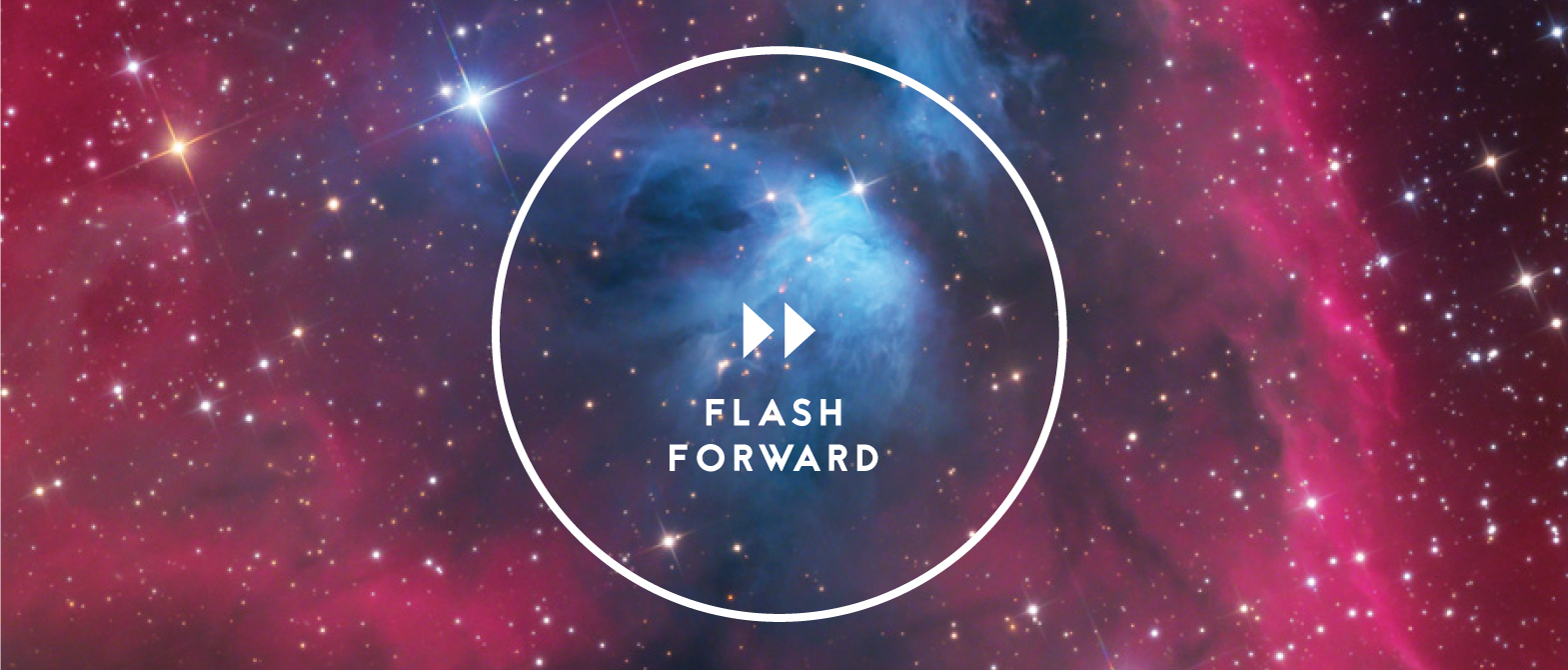
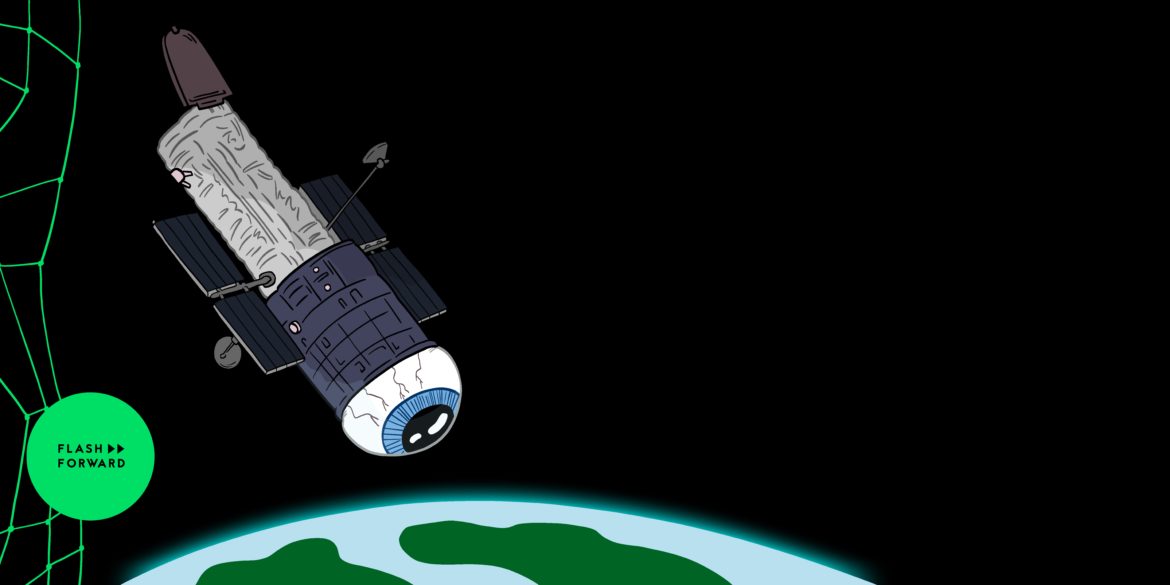
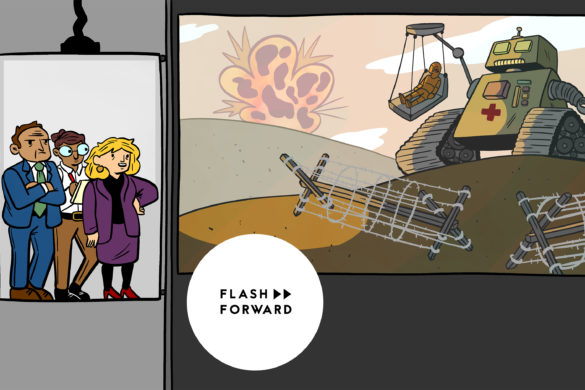
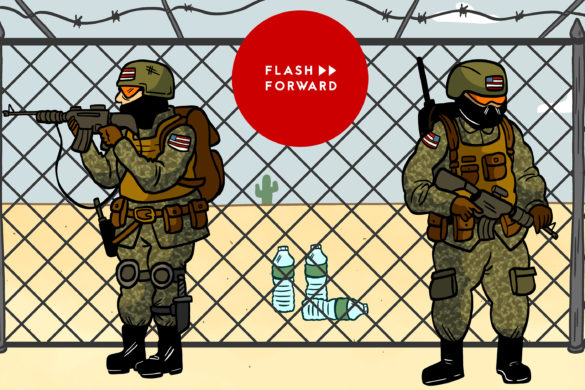
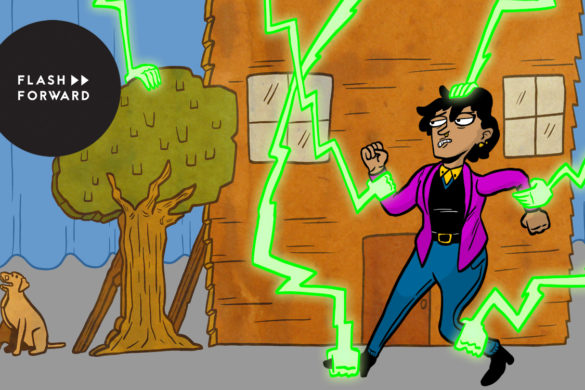
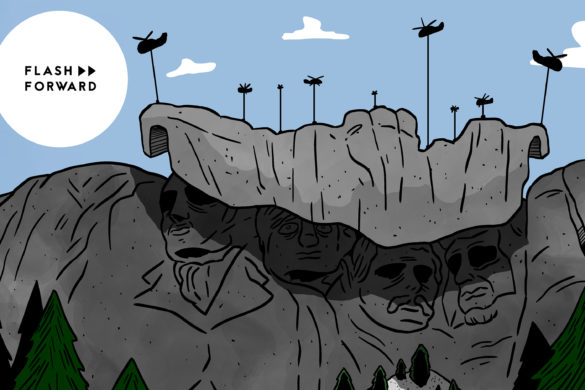
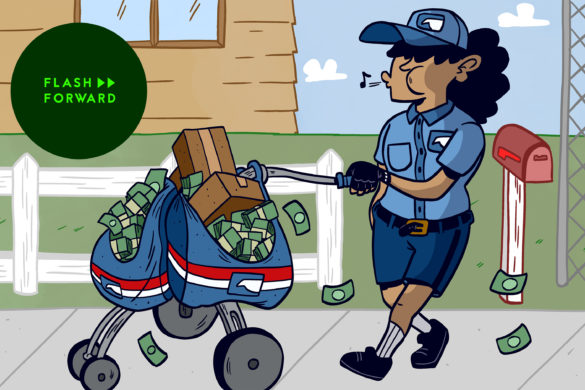
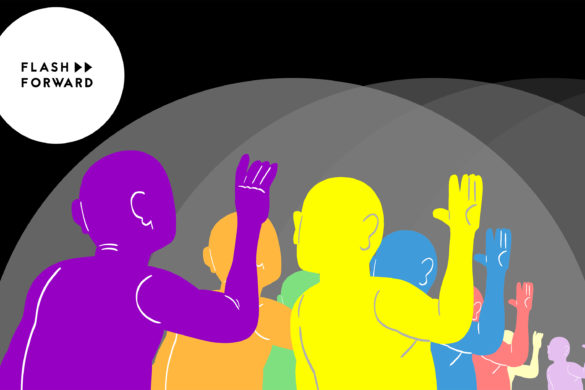
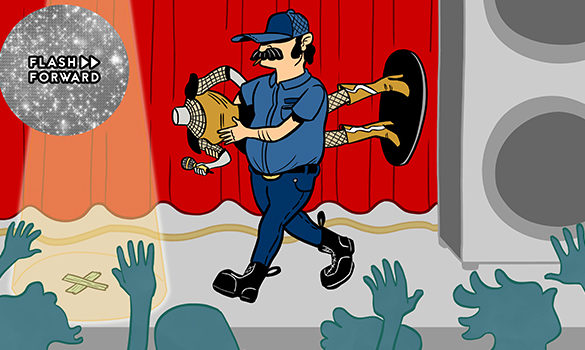
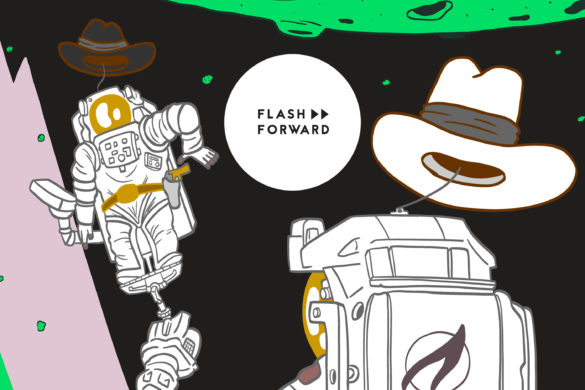
1 comment
[…] CRIME: I Can See My House From Here! […]